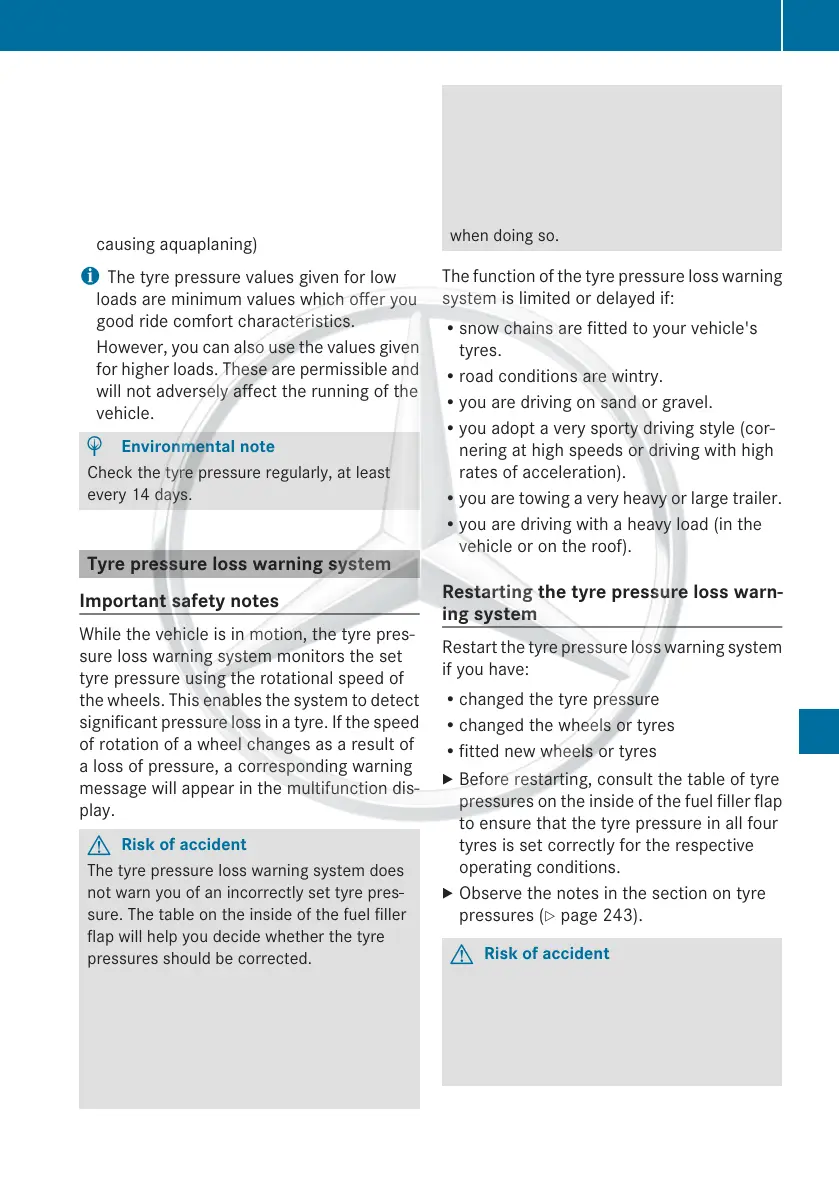Driving with tyre pressure thatis too high or
too low can:
R
shorten the service life of the tyres
R
cause increased tyre damage
R
have a negative effect on handling charac-
teristics and thus the driving safety (e.g. by
causing aquaplaning)
i
The tyre pressure values given for low
loads are minimum values which offer you
good ride comfort characteristics.
However, you can also use the values given
for higher loads. These are permissible and
will not adversely affect the running of the
vehicle.
H
Environmental note
Check the tyre pressure regularly, at least
every 14 days.
Tyre pressure loss warning system
Important safety notes
While the vehicle is in motion, the tyre pres-
sure loss warning system monitors the set
tyre pressure using the rotational speed of
the wheels. This enables the system to detect
significant pressure loss in a tyre. If the speed
of rotation of a wheel changes as a result of
a loss of pressure, a corresponding warning
message will appearinthe multifunction dis-
play.
G
Risk of accident
The tyre pressure loss warning system does
not warn you of an incorrectly set tyre pres-
sure. The table on the inside of the fuel filler
flap will help you decide whether the tyre
pressures should be corrected.
The tyre pressure loss warning system does
not replace the need to regularly check your
vehicle's tyre pressures, since an even loss of
pressure on several tyres at the same time
cannot be detected by the tyre pressure loss
warning system.
The tyre pressure monitor is not able to warn
you of a sudden loss of pressure, e.g. if the
tyre is penetrated by a foreign object.
In the event of a sudden loss of pressure, bring
the vehicle to a halt by braking carefully. Do
not make any sudden steering movements
when doing so.
The function of the tyre pressure loss warning
system is limited or delayed if:
R
snow chains are fitted to your vehicle's
tyres.
R
road conditions are wintry.
R
you are driving on sand or gravel.
R
you adopt a very sporty driving style (cor-
nering at high speeds or driving with high
rates of acceleration).
R
you are towing a very heavy or large trailer.
R
you are driving with a heavy load (in the
vehicle or on the roof).
Restarting the tyre pressure loss warn-
ing system
Restart the tyre pressure loss warning system
if you have:
R
changed the tyre pressure
R
changed the wheels or tyres
R
fitted new wheels or tyres
X
Before restarting, consult the table of tyre
pressures on the inside of the fuel filler flap
to ensure that the tyre pressure in all four
tyres is set correctly for the respective
operating conditions.
X
Observe the notes in the section on tyre
pressures (Y page 243).
G
Risk of accident
The tyre pressure loss warning system can
only give reliable warnings if you have set the
correct tyre pressure.
If an incorrect tyre pressure is set, these
incorrectvalues will be monitored.
Tyre pressure
245
Tyres and wheels
Z

